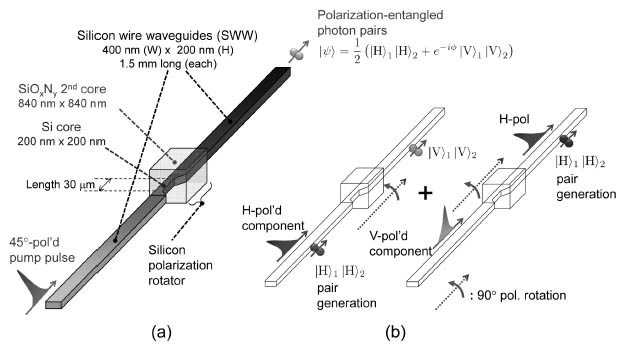Koji Yamada2, 3, and Hiroki Takesue1
1Optical Science Laboratory, 2NTT Microsystem Integration Laboratories,
3Nanophotonics Center
Integrated photonic waveguides, which provide a highly-stable
and ultra-compact optical circuitry, is a promising candidate for a platform
of scalable photonic quantum information processing (QIP) system [1]. Many
QIP protocols are based on photonic quantum states encoded in polarization
degree of freedom. Therefore, it is essential to implement integrated subsystems
to generate, manipulate and measure polarization-encoded quantum states
of light. This time we realized the first monolithic source of polarization
entangled photon pairs by employing the silicon photonics technology [2].
The device consists of two silicon-wire waveguides (SWWs)
connected by a silicon polarization rotator (SPR) [Fig. 1(a)]. In a SWW,
a correlated pair of signal and idler photons is created following the
annihilation of two pump photons via spontaneous four-wave mixing process.
Here the pump, signal and idler photons are horizontally (H) polarized.
The SPR has an off-axis double core structure of a Si inner core and a
SiOxNy outer core. The SPR exhibits two orthogonal eigenmodes, which have different effective refractive indices and eigen-axes tilted at 45° with respect to the normal to the substrate [3]. The birefringence in
the eigenmodes causes the polarization plane to rotate by an amount that
depends on the length of the SPR. We obtain polarization-entangled photon
pairs from the device by using optical pump pulses with + 45° linear polarization as shown in Fig. 1. The polarization-mode dispersion
and the polarization-dependent loss in a SWW, which potentially degrade
the purity of polarization entanglement, can be automatically cancelled
out in our device. We successfully obtained a maximally entangled state
from the chip with a state fidelity as high as 94 %, which is well above
the classical limit.
This work was supported by KAKENHI.
[1] A. Peruzzo et al., Science 329 (2010) 1500.
[2] N. Matsuda et al., Sci. Rep. 2 (2012) 817.
[3] H. Fukuda et al., Opt. Express 16 (2008) 2628.
 |
||
|